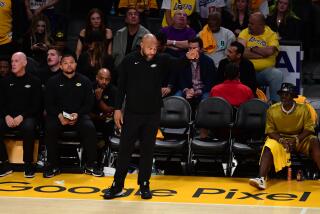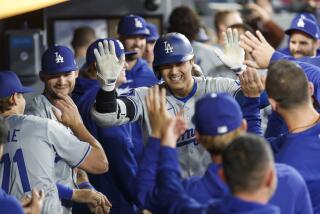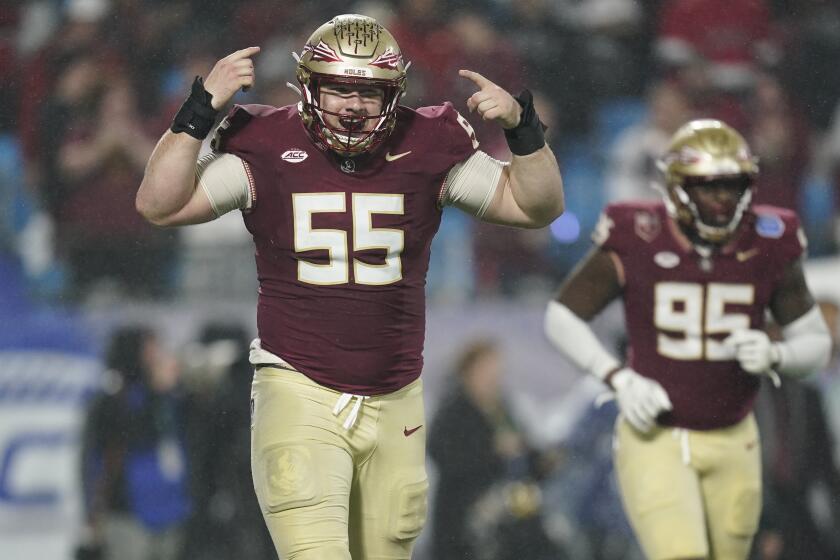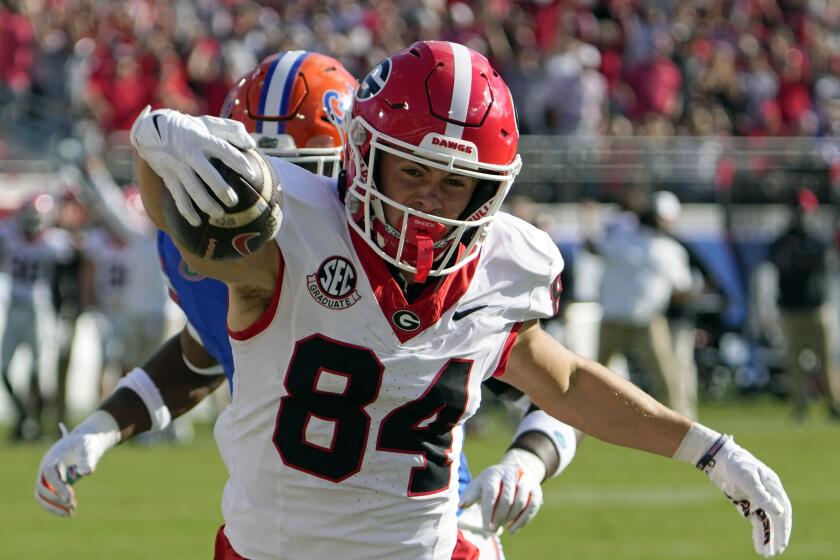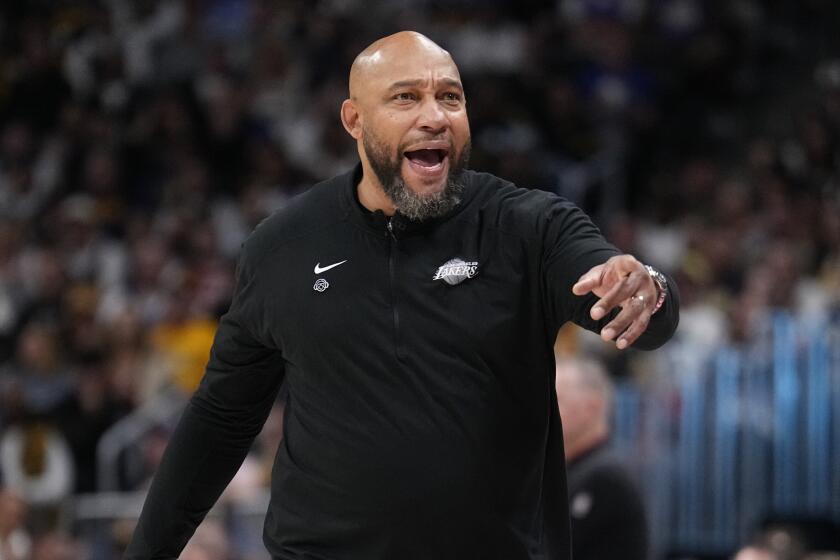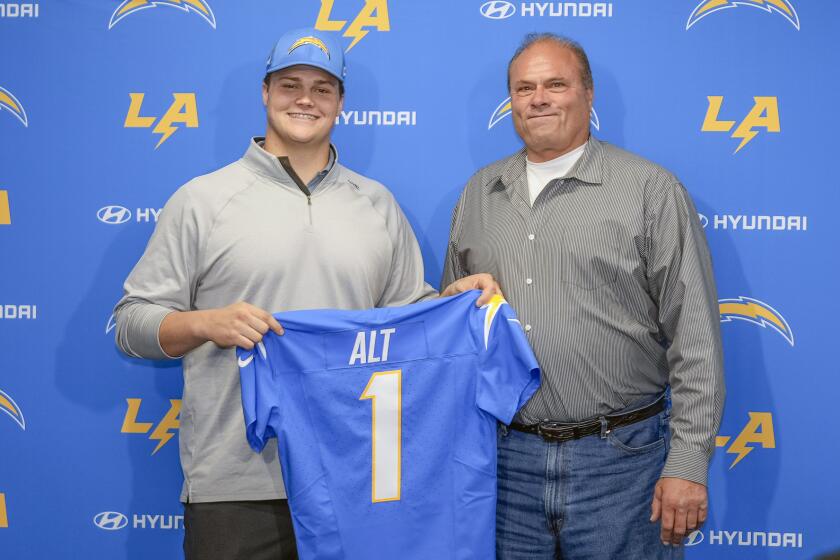West Coast Dead
The St. Louis Rams are doing the unthinkable. With their attack-passing system, they’re killing off the West Coast Offense as the best way to play football in the 21st Century.
A West Coast team runs the ball too often to outscore a pro club that is committed to pass offense, as both organizations, the St. Louis passing team and the Seattle Seahawks’ run-pass team, have shown in two duels this fall.
On Oct.10, a late flurry of Ram passes won a 33-27 game that Seattle, with a careful regard for West Coast principles, had led into the final six minutes, 27-10.
Five weeks later, an early flurry of Ram passes scored 17 quick points and put the Seahawks so far out of Sunday’s 23-12 game that they couldn’t catch up running the ball.
But as a West Coast team, run it they did. Seattle running back Shaun Alexander took 22 handoffs for 176 yards, often running at will through the Ram defense — which, later, was honored by some fans as the winner of the game for holding Seattle to four field goals. A more accurate assessment is that the Seahawks ran the ball so often that there wasn’t time for the pass plays they needed to hang with a passing team. When the game was on the line, the Rams attacked with passes on almost every down. The Seahawks blew it handing off to Alexander.
West Coast Values Passing and Running Both
WEST COAST OFFENSE teams have remade football in recent years, bringing back the pass plays that most coaches had ignored for a quarter century after Vince Lombardi started winning Super Bowls in the early 1960s. Lombardi’s most famous play as an NFL coach, the Green Bay sweep, tells it. His were running teams; and Green Bay’s rivals fell into line. By the 1970s, one of them won a Super Bowl game with a total of seven passes.
That was the mind-set Bill Walsh changed in the 1980s when, as Joe Montana’s coach, he developed the West Coast Offense, in which the San Francisco 49ers passed the ball about as often as they ran it — most noticeably on first down. Their run-pass balance was shown not in the final statistics but in the moments when the game was on the line.
There was more to the West Coast, of course, than short passing. But that was enough to unseat the conservatives who had always feared that of the three things that can happen when a football is in the air, two are bad. The NFL’s best coaches, noting Walsh’s Super Bowl successes with Montana’s ball-control passing, copied. And, soon, most of the Super Bowls were being won by teams with good passers from Dan Marino to Brett Favre.
Still, those teams also made it a point to run well too, running about half the time — and that’s what changed in and after the 2000 Super Bowl when the Rams (and, later, the New England Patriots) began to throw most of the time — on nearly every down with the game on the line.
As of 2004, passing teams haven’t yet remade the NFL. But the league was watching closely Sunday when, for the second time this season, the best of the West Coast teams, Seattle — running half the time — couldn’t outscore an opponent that attacked with pass plays on down after down.
Rams Attack with Best Pass-Offense Personnel
THE RAM LEADER, Mike Martz, is less than a rabid advocate of attack passing. In recent weeks, the Rams have come out running the ball with Marshall Faulk — usually running to nowhere on first-down carries — as often as they’ve come out passing to Faulk, who, on pass plays, is the most dangerous running back in the league.
There’s just no telling what Martz will decide to do next Sunday in Buffalo, where, if he reverts to his rather ordinary running game, the Bills might make it close. The Rams, who could be 9-0 if they’d attacked every opponent with Martz’s cleverly designed pass plays, are 5-4 because they haven’t.
It was just Seattle’s tough luck that Martz chose last Sunday to strike with passes by quarterback Marc Bulger, the best middle-range passer I’ve seen in more than 60 years of NFL football and the most accurate marksman of them all today. Except for two runs, the Rams threw the ball every time they had it in the first quarter until they had a 14-0 lead. And they kept throwing into the second quarter, when, on third and 18, Bulger’s great pass of the game reached second-year wide receiver Shaun McDonald falling into the end zone. Surrounded by three Seahawk blitzers as he fired, Bulger hit McDonald squarely in the midst of three other converging Seahawks.
On an official’s call that clearly could have gone either way, McDonald lost the touchdown when the ball was juggled well after he was down. So the Ram lead was 17-0 instead of 21-0 with nearly three quarters remaining of a game in which not another touchdown was scored. For Martz began running Faulk again. And Seattle kept unsuccessfully playing catch-up with Alexander’s runs.
The Rams, however, during their spectacular first-quarter attack, continuously showed off perhaps the league’s top six-man contingent of wide receivers: the veterans Isaac Bruce and Torry Holt plus the youngsters McDonald, Mike Furrey, Dane Looker and Kevin Curtis. Plus Faulk. Not to forget Bulger. What a team.
Owens Stars in Dummy Scrimmage at Dallas
THE PHILADELPHIA EAGLES won an easy 49-21 Monday nighter at Dallas under the leadership of quarterback Donovan McNabb in a game illustrating that parity isn’t yet universal in the NFL. Rather, the extent of talent disparity in pro football has been presented with almost mathematical clarity in Philadelphia’s first two games this month.
Less than a week before the Eagles unloaded on the Cowboys, they were all out to make three points — one lousy field goal — against the Pittsburgh defense.
Before the Steelers blew them away that day, 27-3, the then-unbeaten Eagles had known precisely what they were up against. The Steelers, with Big Ben Roethlisberger in MVP form, had just hammered the only NFL team that was ever still undefeated after playing 21 consecutive games: the then-6-0 New England Patriots. A two-touchdown game (34-20), it really wasn’t that close
The Pittsburgh-Philadelphia picture that lingers most vividly in the memory is of McNabb taking one quick step back from center, as he always does, before disappearing from sight when surrounded by hordes of angry Steelers. It was as if there were no Eagle blockers on the field.
The most descriptive Dallas-Philadelphia picture, by contrast, shows McNabb circling endlessly in his own backfield — unhindered by the Cowboys, most of whom had been blocked away — before depositing a bomb far downfield. It was as if there were no Cowboys in their own defense.
Indeed, the Dallas-Philadelphia game was more like a July scrimmage than a big game in November. How could the Dallas talent level be so much below Philadelphia’s? Or Pittsburgh’s? When they’re all in the same league? When they draft out of the same talent pool?
There must be an answer. Maybe someone will find out from Terrell Owens, the strange Eagle who seems to have an answer for everything. Watching Owens execute three big touchdown plays — as the best wide receiver in football, the fastest, and a candidate for NFL’s best athlete — made the dummy scrimmage worthwhile.
Ben Roethlisberger, Meet Carson Palmer
THE PTTSBURGH STEELERS, still listed in most precincts as the NFL’s top team, will be in Cincinnati next Sunday in a matchup of famous rookie quarterbacks. The host is Carson Palmer, the Heisman Trophy winner from co-national champion USC, who is 4-5 in his first year as an NFL starter. His guest, Roethlisberger, from Mid-American Conference champion Miami (Ohio), is 7-0 in his first year as an NFL starter.
Roethlisberger came to national fame only gradually in his first two months as the quarterback in a conventional NFL offense. Instead of attacking with passes — as the Rams and Patriots have learned to do — the Steelers (8-1) attack with runs by Jerome Bettis, who gets the ball on most first-down handoffs and often on second down. When those plays fail to combine for 10 or more yards, Roethlisberger is called on to throw the ball on third down.
Third is the toughest down for a passer. It’s so tough that it is defensive players, not quarterbacks, who are most definitively evaluated on third down. A pass defense is rated as pretty bad if it can’t even break up third-down passes.
On third and four or more, quarterbacks are either blitzed or their best receivers are all double-covered. It is a mark of Roethlisberger’s poise and talent that he is so often effective on third-down passes or scrambles. Many of his big winning plays this year have been made in the all-or-nothing crises of third down.
Palmer, as the new young quarterback of the Bengals (4-5), has also been asked to learn the trade while mopping up on third down for the inefficiencies of others. Through no fault of his own, Palmer, though, has been less successful than Roethlisberger. The explanation is that Pittsburgh’s veteran coaches have built a much better all-around team than Marvin Lewis could have been expected to develop in only his first year and a half as the leader of the long-awful Bengals.
No pro quarterback can do it on his own. In San Francisco, Montana won not with his weak arm but with his strong coach, Bill Walsh. In Pittsburgh, Roethlisberger is serving the most experienced coach in pro football, Bill Cowher. In Cincinnati, Palmer, who might be the best passer of the three, is serving coaches and players who are still in transition from nothingness to wherever Lewis can haul them someday. The one thing that identifies Roethlisberger as a definite comer is his steadiness as a third-down quarterback. In a passer, few assets are more unusual or more valuable.
More to Read
Get our high school sports newsletter
Prep Rally is devoted to the SoCal high school sports experience, bringing you scores, stories and a behind-the-scenes look at what makes prep sports so popular.
You may occasionally receive promotional content from the Los Angeles Times.

